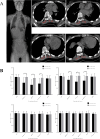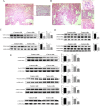Plasma exosome proteomics reveals upregulation of CILP-1 in concave side of paraspinal muscle in adolescent idiopathic scoliosis
- PMID: 40461962
- PMCID: PMC12131353
- DOI: 10.1186/s12014-025-09542-8
Plasma exosome proteomics reveals upregulation of CILP-1 in concave side of paraspinal muscle in adolescent idiopathic scoliosis
Abstract
Background: There is insufficient attention to the pathogenesis of abnormal radiological changes and molecular mechanism in the paraspinal muscles in AIS patients.
Methods: Proteomics of plasma exosomes were applied for identification of differentially expressed proteins (DEPs) in AIS patients through liquid chromatography mass spectrometry (LC-MS/MS). Bioinformatic analysis were performed to explore biomarkers. The muscle density (HU value) of the concave and convex sides of paravertebral muscles in AIS patients was compared. HE staining were applied for investigation of pathological changes of paravertebral muscles. Cartilage intermediate layer protein-1 (CILP-1), TGF-β1/Smad pathway and the downstream proteins were compared between the concave and convex side of paraspinal muscle. C2C12 cells were incubated with TGF-β1 or Smad3 phosphorylation inhibitor (SIS3) to further clarify the correlation between CILP-1 and TGF-β1/Smad pathway.
Results: A total of 2437 proteins were identified, among which DEPs were enriched in immune response and extracellular matrix-receptor interaction, while CILP-1 was screened out. HU value of concave multifidus muscle (MF) in apical vertebrae area was significantly lower when compared with both convex MF and control group. Muscle fibrosis, increased CILP-1, TGF-β1 phosphorylation of Smad2/3 and downstream proteins could be observed in the concave side of paraspinal muscle. TGF-β1 stimulation resulted in upregulation of CILP-1 and ECM related proteins, which could be partially inhibited by SIS3.
Discussion: We confirmed the asymmetric expressions of CILP-1 and TGF-β1/Smad signaling pathways in the paravertebral muscles of AIS patients. In C2C12 cells, TGF-β1 induced up-regulation of CILP-1 expression via Smad3 phosphorylation.
Keywords: Adolescent idiopathic scoliosis; CILP-1; Exosome; Paraspinal muscle; TGF-β1.
© 2025. The Author(s).
Conflict of interest statement
Declarations. Competing interests: The authors declare no competing interests.
Figures










Similar articles
-
Biological effect of dysregulated LBX1 on adolescent idiopathic scoliosis through modulating muscle carbohydrate metabolism.Spine J. 2022 Sep;22(9):1551-1565. doi: 10.1016/j.spinee.2022.04.005. Epub 2022 Apr 21. Spine J. 2022. PMID: 35460899
-
[Expression of transforming growth factor-beta1 and basic fibroblast growth factor in articular process cartilages of adolescent idiopathic scoliosis].Zhonghua Yi Xue Za Zhi. 2006 Jun 6;86(21):1478-83. Zhonghua Yi Xue Za Zhi. 2006. PMID: 16842701 Chinese.
-
Cartilage intermediate layer protein-1 alleviates pressure overload-induced cardiac fibrosis via interfering TGF-β1 signaling.J Mol Cell Cardiol. 2018 Mar;116:135-144. doi: 10.1016/j.yjmcc.2018.02.006. Epub 2018 Feb 10. J Mol Cell Cardiol. 2018. PMID: 29438665
-
Is spinal neuromuscular function asymmetrical in adolescents with idiopathic scoliosis compared to those without scoliosis?: A narrative review of surface EMG studies.J Electromyogr Kinesiol. 2022 Apr;63:102640. doi: 10.1016/j.jelekin.2022.102640. Epub 2022 Feb 7. J Electromyogr Kinesiol. 2022. PMID: 35219074 Review.
-
Central role of dysregulation of TGF-β/Smad in CKD progression and potential targets of its treatment.Biomed Pharmacother. 2018 May;101:670-681. doi: 10.1016/j.biopha.2018.02.090. Epub 2018 Mar 22. Biomed Pharmacother. 2018. PMID: 29518614 Review.
References
LinkOut - more resources
Full Text Sources
Research Materials
